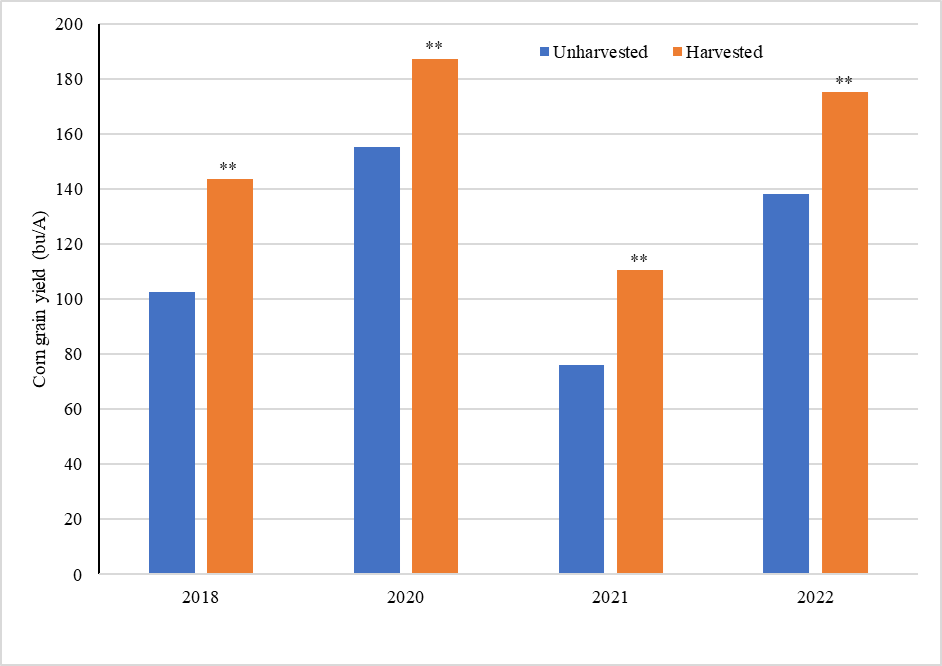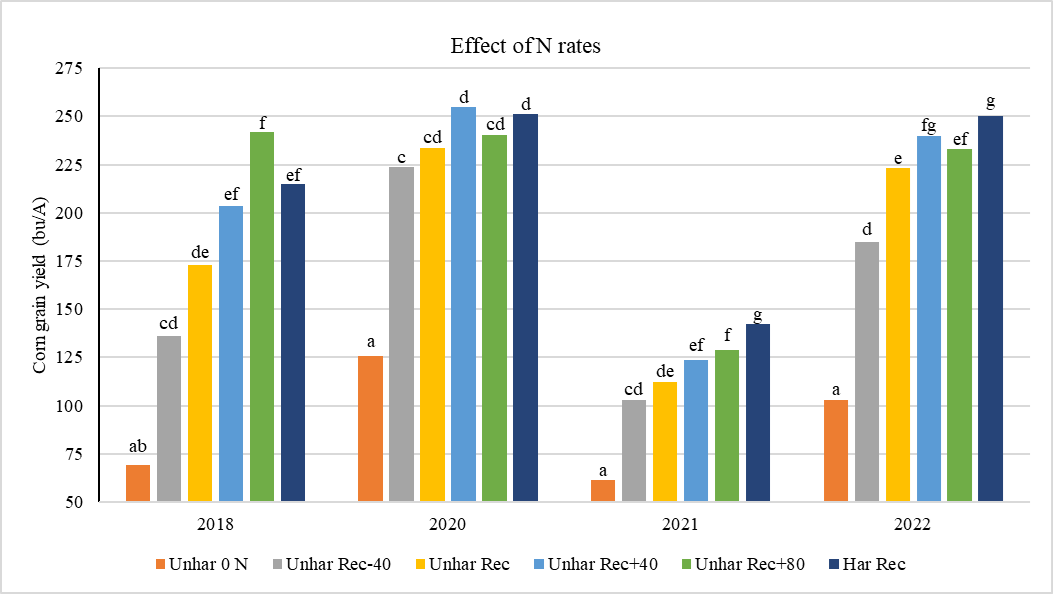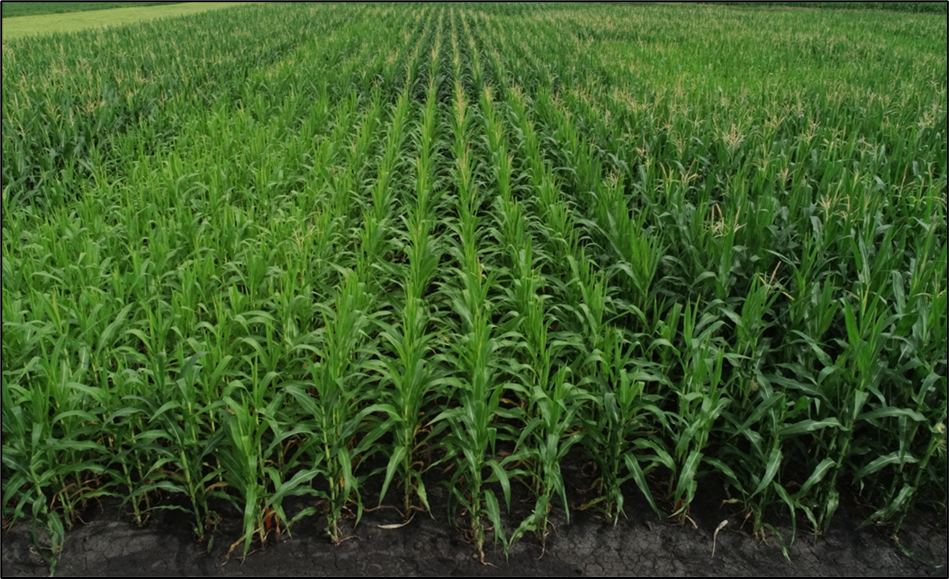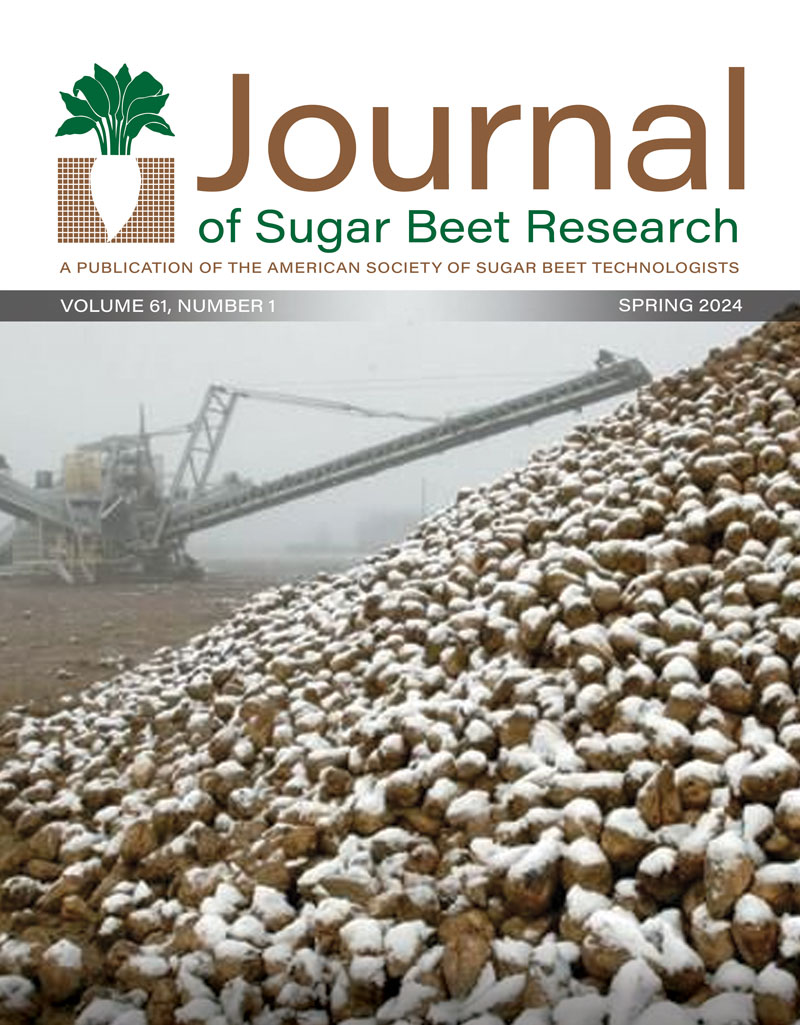The goal of Southern Minnesota Beet Sugar Cooperative (SMBSC) is to optimize the sugar factory’s capacity. To do this the grower’s goal is to raise enough high quality sugar beets to meet the needs of the factory. Some years this may mean sugar beet acres will not be harvested because of a greater than anticipated root yield and a limited slice capacity. Little information exists on management practices for optimum field corn production following unharvested sugar beets.
Research Objectives
- Determine what management practices are useful for optimum field corn production following unharvested sugar beets. Specifically answering the following questions: 1). Do the unharvested roots need to be removed, 2). Does the use of starter fertilizer help corn production, and 3). Does the corn crop need more nitrogen fertilizer applied after unharvested roots compared to harvested roots?
Methodology
A study was conducted on field corn grown in 2018, 2020, 2021, and 2022 to answer these objectives. The study was located near the SMBSC factory in Renville, MN in 2018, near Murdock, MN in 2020, near Cosmos, MN in 2021, and near Maynard, MN in 2022. In 2017, 2019, 2020, and 2021, the sites were planted to sugar beet and the beets were defoliated but not harvested except for selective treatments. All but three treatments had unharvested sugar beet left in the plot (Photos 1 and 2). Field corn was planted the following year at a rate of 34,000 seeds/A using a glyphosate tolerant variety (E696RR). The study included the treatments listed in Table 1. The experimental design was a randomized complete block with four replications. Plots were 6 rows wide on 22 inch spacing and 35 feet in length. Nitrogen fertilizer rates were based on a soil test to 2 feet. Since the soil nitrate-N was low, the MRTN recommendation for corn/corn was used at a price ratio of 0.10 = 155lbs N/A. Seven gallons of 10-34-0 plus 1 lb zinc/A was used as an infurrow starter on all but treatments 1 and 8. Nitrogen treatments were applied as broadcast urea and incorporated with a small field cultivator. In 2018, the site was hand harvested on October 30, the 2020 site was machine harvested on November 4, the 2021 site was hand harvested on September 30, and the 2022 site was hand harvested on October 12. Twenty feet from the center two rows were harvested and sent to the University of Minnesota for shelling and yield analysis. Yield data were analyzed using SAS 9.4 Proc GLM and non-orthogonal contrasts.
Table 1. Treatments for field corn following sugar beet production.
| Treatment | Beets | Starter | Nitrogen rate |
| 1. | Unharvested | none | 0 |
| 2. | Unharvested | 7 gallons 10-34-0 plus 1 lb Zn/acre | 0 |
| 3. | Unharvested | 7 gallons 10-34-0 plus 1 lb Zn/acre | Recommended – 40lbs N/A (115lbs N/A) |
| 4. | Unharvested | 7 gallons 10-34-0 plus 1 lb Zn/acre | Recommended (155lbs N/A) |
| 5. | Unharvested | 7 gallons 10-34-0 plus 1 lb Zn/acre | Recommended + 40lbs N/A (195lbs N/A) |
| 6. | Unharvested | 7 gallons 10-34-0 plus 1 lb Zn/acre | Recommended + 80lbs N/A (235lbs N/A) |
| 7. | Harvested | 7 gallons 10-34-0 plus 1 lb Zn/acre | Recommended (155lbs N/A) |
| 8. | Harvested | None | 0 |
| 9. | Harvested | 7 gallons 10-34-0 plus 1 lb Zn/acre | 0 |
Results
2018
The corn grain yields were variable because of the very wet weather experienced in 2018. The statistics and corn yields are reported in Table 2. Even with the large variability, grain yields were significantly affected by the treatments. The corn grown where the sugar beet roots were harvested, yielded 35 bu/A greater than the corn grown where the beet roots were unharvested, Fig. 1. Additional nitrogen (N) fertilizer was needed for better grain yields. The increase in grain yield was 102 bu/A when the check was compared to the recommended N rate, Fig 2. Additional N was also needed for corn grown where the beet roots were unharvested. The corn grown after the unharvested sugar beet responded to an additional 80lbs N/A above the recommended N amount. The use of starter did not have a positive effect on corn grain yield, Fig 3. The wet conditions in 2018 were significantly greater than other years the trial was conducted as shown in Table 3.
2020
The corn grain yields were high because of the ideal weather experienced in 2020. The statistics and corn yields are reported in Table 2. Grain yields were significantly affected by the treatments. There was a significant increase in corn yield of 31 bu/acre if the sugar beets were harvested, Fig 1. The difference in corn yield of 14 bu/A with the use of starter (7 gallons 10-34-0 plus 1lb Zn/A) was significant at the P<0.07 level, Fig 3. The use of N fertilizer at the recommended rate significantly increased corn grain yields by 100 bu/A over the check, Fig. 4. The use of an additional 40lbs N/A above the recommended rate significantly increased grain yield 21 bu/A, for corn grown where sugar beet was unharvested the previous fall. Applying 80lbs N/A above the recommended rate did not increase the corn grain yield above the extra 40lbs N/A application. It took 40lbs N/A above the recommended N rate for the corn grain yield on the unharvested treatment to be equal to the corn grain yield with recommended N application for the corn grown where the sugar beets were harvested the previous fall.
2021
The corn grain yields were poor because of drought conditions. The statistics and corn grain yields are reported in Table 2. Grain yields were significantly affected by the treatments. There was a significant increase in corn yield of 34 bu/A if sugar beet was harvested, Fig. 1. The difference in corn yield of 7 bu/A with the use of starter (7 gallons 10-34-0 plus 1lb Zn/A) was significant (P<0.09), Fig 3. The use of N fertilizer at the recommended rate significantly increased corn grain yields by 47 bu/A, Fig 2. The use of an additional 40 lbs N/A fertilizer above the recommended rate significantly increased grain yield 12 bu/A, at the 0.05 probability, for corn grown where sugar beet was unharvested the previous fall. Applying 80lbs N/A above the recommended rate did not significantly increase the corn grain yield above the extra 40lbs N/A application. In 2021, additional N to the unharvested treatment did not make it yield as well as the corn grown where sugar beet had been harvested the previous fall.
2022
The corn grain yields were good but not extra ordinary, Table 2. This was caused by wet planting conditions and dry conditions from August to harvest. The corn grain yields were significantly affected by treatments. Corn grain yields were 37 bu/A greater if sugar beet roots were harvested, Fig. 1. The use of starter increased corn grain yields 25 bu/A, Fig. 3., and the use of N fertilizer where the sugar beet root was unharvested increased corn grain yield by 108 bu/A, Fig. 2. The application of 40lbs N/A greater did increase corn grain yield where the sugar beet roots were unharvested compared to the recommended N application. Increasing the rate by 80lbs N/A did not increase the corn grain yield above the extra 40lbs N/A application. The use of additional N did not bring the corn grain yields equal to the corn grown where the sugar beet roots were harvested and the recommended rate of N was applied.
Photo 1. Renville site on October 26th, 2017, during sugar beet harvest prior to planting field corn in 2018.

Table 2. Corn grain yield and statistical analysis for 2018, 2020, 2021, and 2022.
| Grain yield 15.5 % (bu/A) | |||||||
| Treatment | Beets | Starter | N rate | 2018 | 2020 | 2021 | 2022 |
| 1. | Unharvested | none | 0 | 84 | 107 | 55 | 87 |
| 2. | Unharvested | 7 gallons 10-34-0 plus 1 lb Zn/A | 0 | 69 | 126 | 61 | 103 |
| 3. | Unharvested | 7 gallons 10-34-0 plus 1 lb Zn/A | Recommended – 40lbs N/A (115lbs N/A) | 136 | 224 | 103 | 185 |
| 4. | Unharvested | 7 gallons 10-34-0 plus 1 lb Zn/A | Recommended
(155lbs N/A) |
173 | 234 | 112 | 223 |
| 5. | Unharvested | 7 gallons 10-34-0 plus 1 lb Zn/A | Recommended + 40lbs N/A
(195lbs N/A) |
203 | 255 | 124 | 240 |
| 6. | Unharvested | 7 gallons 10-34-0 plus 1 lb Zn/A | Recommended + 80lbs N/A
(235lbs N/A) |
242 | 241 | 129 | 232 |
| 7. | Harvested | 7 gallons 10-34-0 plus 1 lb Zn/A | Recommended
(155lbs N/A) |
215 | 251 | 142 | 250 |
| 8. | Harvested | None | 0 | 101 | 150 | 90 | 120 |
| 9. | Harvested | 7 gallons 10-34-0 plus 1 lb Zn/A | 0 | 115 | 160 | 99 | 154 |
| LSD0.05 | 47 | 21 | 12 | 17 | |||
| Grand mean | 149 | 196 | 102 | 176 | |||
| Statistical Analysis | P>f | ||||||
| Treatment | 0.0001 | 0.0001 | 0.0001 | 0.0001 | |||
| Contrasts | |||||||
| Harvest vs Unharvest | 0.02 | 0.0001 | 0.0001 | 0.0001 | |||
| Starter vs No Starter | 0.99 | 0.07 | 0.09 | 0.0005 | |||
| 0 N vs Recommended | 0.0001 | 0.0001 | 0.0001 | 0.0001 | |||
| C.V. % | 21.6 | 7.2 | 8.3 | 6.7 | |||
Table 3. Monthly precipitation for Granite Falls, MN from the National Weather Service NOAA Online Weather Data compared to normal yearly rainfall of 28 inches. Precipitation on actual trial sites may have varied, with the 2021 site being much drier than officially reported at Granite Falls.
| Year | Jan | Feb | Mar | Apr | May | Jun | Jul | Aug | Sep | Oct | Nov | Dec | Annual |
| 2018 | 0.26 | 1.25 | 2.51 | 2.47 | 2.36 | 8.04 | 6.78 | 3.47 | 7.21 | 3.23 | 1.18 | 1.34 | 40.10 |
| 2020 | 1.70 | 0.63 | 1.65 | 1.00 | 2.39 | 4.97 | 2.76 | 5.86 | 2.07 | 2.20 | 1.19 | 0.69 | 27.11 |
| 2021 | 1.03 | 0.40 | 2.65 | 2.38 | 2.39 | 0.32 | 1.87 | 5.56 | 3.24 | 3.60 | 0.61 | 1.59 | 25.64 |
| 2022 | 0.95 | 0.41 | 1.36 | 3.09 | 7.83 | 1.20 | 2.57 | 2.89 | 1.33 | 0.44 | 1.50 | 2.31 | 25.88 |
Combined Analysis
In the combined statistical analysis across all years, there was an interaction by treatment and year for corn grain yield. This interaction was because of the magnitude of the grain yield response for the use of starter and the response of corn grain yield to nitrogen (N) fertilizer application. In all years of this study, the corn grain yield on unharvested beet ground was less than corn grain yield on harvested beet ground, Figure 1. This effect was similar in all years. To make up for the loss in corn grain yield when grown on ground where the sugar beet was unharvested in the previous year, the use of starter fertilizer and additional N fertilizer were added, Fig 3. The use of starter did not significantly affect corn grain yield in 2018, but it was helpful in 2020, 2021, and 2022, Fig. 3. In each year there was a corn grain yield response to N fertilizer, but the greatest grain yield occurred with the recommended N rate + 80lbs N/A in 2018 and the recommended N rate + 40lbs N/A in 2020, 2021, and 2022, Fig. 2. The corn yields in 2021 were reduced considerably because of drought and the grain yield responses were much smaller. The dark blue columns are the corn grain yields for corn grown on harvested beet plots with the recommended amount of N fertilizer applied. In 2018 and 2020 the corn grain yields from unharvested beet plots were like the harvested beet plots if at least an extra 40lbs of N/A above the recommended N rate was applied.

Figure 1. Effect on corn grain yield after sugar beet production with the beet root “Unharvested” or “Harvested” in 2018, 2020, 2021 and 2022. *Significant using non-orthogonal contrasts at P<0.1. **Significant using non-orthogonal contrasts at P<0.05.

Figure 2. The effect on corn grain yield of added nitrogen fertilizer when grown on ground where the previous sugar beet roots were unharvested in 2018, 2020, 2021, and 2022. Rates are no N, the recommended rate (Rec), 40 lbs below (-40), or with an extra 40 (+40) or 80 (+80). These are compared to the recommended rate applied where beets were harvested (Har Rec).

Figure 3. The effect of starter fertilizer (10-34-0 plus Zn) on corn grain yield grown on ground where the previous sugar beet roots were unharvested in 2018, 2020, 2021, and 2022. *Significant using non-orthogonal contrasts P<0.1. **Significant using non-orthogonal contrasts P<0.05.
Conclusions
This study was conducted in four very different climates. The climate was very wet in 2018, moisture was ideal for producing high corn grain yields in 2020, dry conditions reduced the corn grain yield in 2021, and planting was delayed by wet conditions while the fall was dry in 2022. Although every year was impacted differently by the environment there were always some visual differences between treatments including crop height and color (Photos 3 and 4). In all years, corn grown on unharvested sugar beet production ground had lower grain yields than corn grown on ground where the sugar beet root was harvested. In all production years, the use of 40lbs N/acre above the recommendation on unharvested sugar beet ground increased the corn grain yield. The use of an additional 80 lbs N/acre did not improve the grain yield over the treatment with an extra 40 lbs N/acre. In 2020 and 2022, corn grain yields from an extra 40 lbs N/acre applied to the ground where sugar beet was unharvested the previous fall were able to produce corn grain yields equal to the corn grown in harvested sugar beet ground. In 2021, the corn grain yields in the unharvested ground were not as good as the corn grain yields from the harvested ground. Why the difference? The extra N fertilizer was needed on the corn grown on the unharvested ground because of the added carbon left in the soil by the unharvested beet roots. The unharvested root material adds carbon that temporarily ties up the soil N because of the stimulation of the micro-organisms in the soil. In 2020, there was enough soil moisture for optimum corn growth and microbial activity to overcome the tie up of the soil N. In 2021, the dry fall conditions slowed both the corn growth and the microbial activity so the extra N applied could not overcome the tie up of soil N. In summary, if planting field corn following unharvested beets, the use of starter fertilizer will likely be beneficial and an additional 40 lbs N/A over the recommended corn/corn rate will be needed to achieve a similar yield to field corn following a harvested sugar beet field.
Photo 2. Image taken during planting at the Cosmos site showing beet residue from the previous year in plots that were not harvested.

Photo 3. Drone image taken on July 15th, 2020, at the Murdock site showing differences in crop color and height. In the foreground from left to right are unharvested treatments: 1 (0 lbs N), 2 (0 lbs N plus starter), and 3 (recommended rate – 40 lbs).

Photo 4. Drone image taken on July 1st, 2022, at the Maynard site showing differences in crop canopy fill and color.



